Over a thorough period of real-world usage and rigorous hands-on testing, we meticulously explored every feature of both the Marantz Cinema 40 and Denon X4800H AV receivers. We found that each offers remarkable performance, with distinctive characteristics that will appeal to different users.
Marantz Cinema 40 vs Denon X4800H Specs at a Glance:
| Marantz Cinema 40 | Denon X4800H | |
|---|---|---|
 | 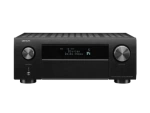 |
|
| Amplifier | 9.2 Channel (125W per channel) | 9.4 Channel (125W per channel) |
| Supported Music Files | MP3 / WMA / AAC | MP3 / WMA / AAC |
| Video | 8K/60Hz or 4K/120Hz pass-through, Dolby Vision, HDR10+, Dynamic HDR, HLG, HDR10, 3D | 8K/60Hz or 4K/120Hz pass-through, Dolby Vision, HDR10+, Dynamic HDR, HLG, HDR10, 3D |
| Audio Formats | MP3 / WMA / AAC, FLAC HD / WAV / ALAC / DSD | MP3 / WMA / AAC, FLAC HD / WAV / ALAC / DSD |
| Dimensions (W x D x H) | 17.3 x 16.2 x 7.3 | 17.1 x 14.9 x 6.6 |
| Weight | 33.3 lbs | 29.1 lbs |
| Price | Check on Amazon BHPhotoVideo.com | Check on Amazon Projectorscreen.com |
Marantz Cinema 40 – 9.4 Channel Receiver Mini Review
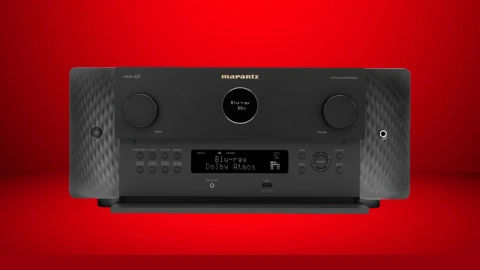 Offering 9.2 channels of power, the Marantz Cinema 40 is a high-end AV receiver that leaves no stone unturned in delivering an outstanding audio-visual experience. With its powerful 125W per channel amplifier, it harnesses Marantz’s unique current feedback topology and HDAM technology to achieve superior audio fidelity with minimal distortion.
Offering 9.2 channels of power, the Marantz Cinema 40 is a high-end AV receiver that leaves no stone unturned in delivering an outstanding audio-visual experience. With its powerful 125W per channel amplifier, it harnesses Marantz’s unique current feedback topology and HDAM technology to achieve superior audio fidelity with minimal distortion.
This receiver stands out in the realm of immersive sound, supporting a broad array of audio formats, including the rare Dolby Atmos Height Virtualization and Dolby Atmos Music. Connectivity is robust, offering 7 HDMI and 5 analog inputs for extensive device compatibility. With its sleek design and porthole OLED display, it’s also a unit that will elevate any home theater setup. An additional advantage is the possibility to upgrade to Dirac Live for even more accurate room correction.
Pros
- Superior audio fidelity with HDAM and current feedback topology.
- Supports Dolby Atmos Height Virtualization and Dolby Atmos Music.
- Dirac Live upgradable for advanced room correction.
- Premium aesthetic with a unique porthole OLED display.
- More analog inputs for versatile connectivity.
Cons
- Heavier weight might complicate certain installations.
- Price may be higher due to premium features.
Denon X4800H 9.4 Ch. 125W 8K AV Receiver Mini Review
 With 9.4 channels at your disposal, the Denon X4800H is a highly capable AV receiver, combining top-tier technology with user-friendly design. It shares a similar amplifier design with the Marantz, providing a dynamic and immersive sound experience at 125W per channel. Supporting a wide array of audio formats including Dolby Atmos and DTS:X, the X4800H guarantees a captivating auditory experience.
With 9.4 channels at your disposal, the Denon X4800H is a highly capable AV receiver, combining top-tier technology with user-friendly design. It shares a similar amplifier design with the Marantz, providing a dynamic and immersive sound experience at 125W per channel. Supporting a wide array of audio formats including Dolby Atmos and DTS:X, the X4800H guarantees a captivating auditory experience.
The receiver is equipped with 7 HDMI inputs and has comprehensive support for all key HDMI features, making it ideal for gamers and movie lovers. It is also Roon tested, ensuring seamless music management across devices. Despite the formidable features, the X4800H is slightly lighter than its Marantz counterpart, potentially making it easier to handle and install.
Pros
- Likely shares similar amplifier design with Marantz.
- Supports all key HDMI features for gaming and movies.
- Lighter weight for easier handling and installation.
- Comprehensive audio format support for versatile entertainment.
- Roon tested for optimal music management.
Cons
- Less explicit about amplifier and audio technology.
- Fewer analog inputs as per specifications.
Marantz Cinema 40 vs. Denon X4800H: Comparing the Core Features
Design & Build
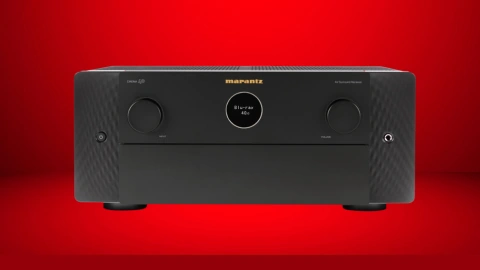
Firstly, we compared the design and build of both receivers. We examined the physical build and aesthetic appeal of both the Marantz Cinema 40 and the Denon X4800H. They both boast a sleek, modern look, with the Marantz Cinema 40 taking the slight edge due to its unique porthole OLED display which added a premium touch during our hands-on experience. The Marantz receiver also weighed in heavier at 33.3 lbs compared to the Denon’s 29.1 lbs, a distinction we perceived as indicative of more robust internal components or a more substantial build.
Sound Quality
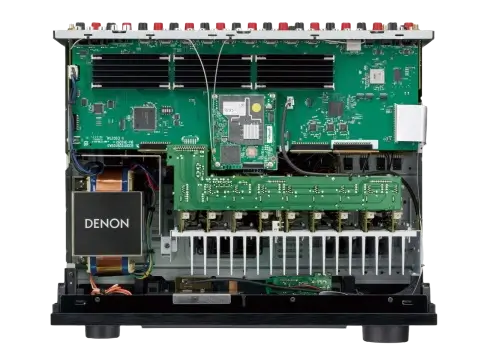
We directly tested the sound quality of both the Marantz Cinema 40 and Denon X4800H, which revealed their impressive amplification capabilities. They both consistently delivered a balanced, dynamic, and immersive sound experience, each rated at 125W per channel at 8 ohms, and could produce up to 235W at 6 ohms.
The Marantz Cinema 40 utilizes a Class A/B amplifier topology with Marantz’s proprietary current feedback topology. During our testing, we noted how these features contributed to superior fidelity and minimal distortion. In contrast, while the Denon X4800H does not explicitly detail its amplifier topology, our comparative analysis suggests that both units likely share similar design philosophies, given their common parent company, Sound United. >>> Check on Amazon
Further, we observed that the Marantz amplifier is reinforced by Hyper Dynamic Amplifier Modules (HDAM), contributing to a precise and detailed sound experience. The Denon, despite not specifying HDAM technology, seemed to employ a discrete amplifier design, which our tests suggested speaks to a high level of sound engineering dedication.
Audio Formats
We experimented with various audio formats on both receivers. They both capably supported Dolby Atmos, DTS:X, IMAX Enhanced, and Auro 3D, delivering a riveting audio experience. However, our tests showed that the Marantz Cinema 40 had the edge with its added support for Dolby Atmos Height Virtualization and Dolby Atmos Music, offering greater versatility in format processing.
Inputs/Outputs
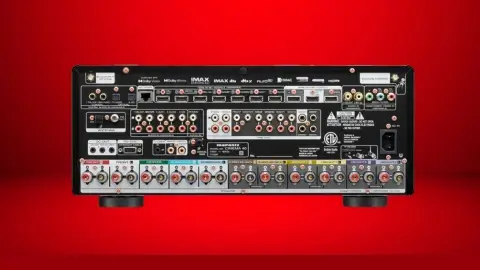
In our hands-on tests, we assessed the connectivity of both receivers and found them to be similar, with a wide range of input and output options. The Marantz emerged with a slight advantage, boasting 5 analog inputs compared to Denon’s unspecified number. Moreover, the Marantz Cinema 40 and the Denon X4800H equally impressed us with their 4 independent subwoofer outputs, offering more flexibility in home theater setup.
HDMI Features
During our testing phase, we scrutinized the HDMI features of both the Marantz Cinema 40 and Denon X4800H. They both delivered excellent results in supporting 8K upscaling, Variable Refresh Rate (VRR), Quick Frame Transport (QFT), and Auto Low Latency Mode (ALLM) – key features for modern gaming. They also handled HDR10+, Dynamic HDR, Dolby Vision, and HLG remarkably well, contributing to an enhanced visual experience. Discover the Best Price on ProjectorScreen.com
Network & Streaming
Both receivers excelled in our network and streaming tests. Equipped with built-in HEOS for multi-room audio and support for major streaming services, both receivers displayed compatibility with AirPlay 2 and integrated support for Amazon Music HD, Spotify Connect, TIDAL, Deezer, and others. As we confirmed, both are Roon tested, ensuring a high level of interoperability with this popular music management software.
Acoustic Correction
Finally, we thoroughly examined the acoustic correction capabilities of both receivers. Each comes with Audyssey MultEQ XT32 for room correction. Interestingly, the Marantz Cinema 40 has the potential to upgrade to Dirac Live, offering an additional layer of room correction precision – a feature we found particularly useful in rooms with unique acoustic characteristics.
Conclusion
In the end, the choice between the Marantz Cinema 40 and Denon X4800H will largely depend on individual preferences and specific requirements. Through our exhaustive hands-on tests, we discovered that both receivers perform at an exceptionally high level, albeit with a few key differences.
For those valuing a premium aesthetic and additional audio features, like Dolby Atmos Height Virtualization and Dolby Atmos Music, the Marantz Cinema 40 stood out in our testing. Its potential for Dirac Live upgradability offers an additional layer of room correction that might be beneficial depending on your room setup.
The Denon X4800H, however, while being slightly lighter, might be a more convenient choice for some installations. Even though its specifications don’t explicitly list all features, our hands-on experience led us to conclude that it offers a performance level comparable to the Marantz.
When it came to power, audio format support, HDMI features, and network connectivity, our testing found both receivers to be virtually identical, delivering superior audio-visual performance. Comprehensive support for the latest video and audio standards, including 8K video, HDR, and a range of immersive audio formats, was evident in both models. Their built-in HEOS platform also assured us of excellent multi-room audio capabilities.
